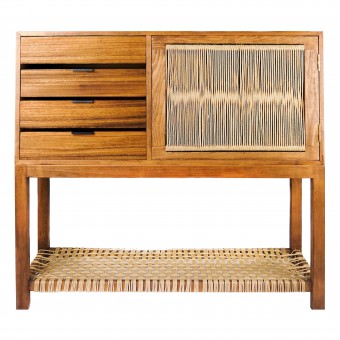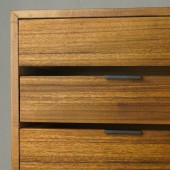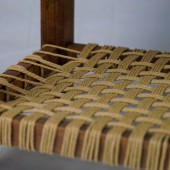
| THE AWARD |
| CATEGORIES |
| REGISTRATION |
| SUBMIT YOUR WORK |
| ENTRY INSTRUCTIONS |
| TERMS & CONDITIONS |
| PUBLICATIONS |
| DATES & FEES |
| METHODOLOGY |
| CONTACT |
| WINNERS |
| PRESS ROOM |
| GET INVOLVED |
| DESIGN PRIZE |
| DESIGN STORE |
| THE AWARD | JURY | CATEGORIES | REGISTRATION | PRESS | WINNERS | PUBLICATIONS | ENTRY INSTRUCTIONS |
Pohihi Entry Console by Raja Badr-El-Din |
Home > Winners > Design #89072 >Interview |
 |
|
FS: What is the main principle, idea and inspiration behind your design?
RB: Designed to tuck away bits and bobs while jointly displaying household favorites. We strove to highlight weaving, as it is an important technique used in my family's cultures, Arab and Hawaiian. As modern homes tend to get cluttered quickly, it was important to create a clean aesthetic that could provide ample storage. Together, the wood and laced danish cord are intended to bring a warm modern feel to the home.
FS: What has been your main focus in designing this work? Especially what did you want to achieve?
RB: Ultimately, we wanted to design a contemporary, low fuss piece that felt true to ourselves, while leaving flexibility for clients to impart their own style and interpretation on it.
FS: What are your future plans for this award winning design?
RB: We are offering this design on a made to order basis, where clients are able to customize elements to suit their personality and spaces. We see this approach as a way to lower the barrier to heirloom quality furniture. Every piece is an opportunity to collaborate, to bring clients something uniquely their own based off of the original design. They may prefer different weaving patterns, combination of woods, or accent details.
FS: How long did it take you to design this particular concept?
RB: We developed this design over 2 months.
FS: Why did you design this particular concept? Was this design commissioned or did you decide to pursuit an inspiration?
RB: We developed this design first for our own home. At the time, we were actively designing a collection of pieces that featured weaving. From the first realized iteration, we made adjustments in material choices, weaving style, and fittings to improve the design.
FS: Is your design being produced or used by another company, or do you plan to sell or lease the production rights or do you intent to produce your work yourself?
RB: We intend to produce the work ourselves from our design and fabrication studio in Maui, Hawaii. We are always available to quote shipping and delivery both on and off island.
FS: What made you design this particular type of work?
RB: In our first collection release, we knew we wanted to have a mix of interior furniture, outdoor grade furniture, and a decorative yet functional surf piece. The Pohihi Entry Console, Hibal Coffee Table, and indoor/outdoor Planter Benches were the first collection designs we pursued.
FS: Who is the target customer for his design?
RB: It really ranges from our perspective. In our design goals overall, we hope to lower the barrier to heirloom quality furniture for families. We want to encourage home owners and renters to look for high quality, long lasting furniture rather than settling for pieces that may deteriorate within two - five years and end up headed to the dump. We hope to develop quality products for all budgets.
FS: What sets this design apart from other similar or resembling concepts?
RB: Our personal approach to the design highlights a handwoven touch that is not common in mass produced designs.
FS: How did you come up with the name for this design? What does it mean?
RB: In our design names, we share both Hawaiian and Arabic words. Pohihi, from Hawaiian, represents two thoughts for us. The first is the console’s function of hiding your belongings. It also represents a unique complex time, navigating the first few months of small business ownership.
FS: Which design tools did you use when you were working on this project?
RB: In line with our typical design process with and without clients, we started with pen and paper. We like to model our designs in CAD and gather material options before getting to work on fabrication in our studio workshop.
FS: Is your design influenced by data or analytical research in any way? What kind of research did you conduct for making this design?
RB: Much of our design decision making was driven by personal interest in how cultural representation works together with contemporary practice. We pursued qualitative information from this perspective. We also researched weaving materials for longevity and accessibility.
FS: What are some of the challenges you faced during the design/realization of your concept?
RB: One of the most challenging aspects of designing a piece with multicultural intent is leaving flexibility for future clients or customers to impart their own style and interpretation on it. There's also much more to share from a cultural and locale perspective than what is stereotypical. There is more to island style than white washing wood; more to Hawaiian design than kapa motifs. There is more to Arab art than calligraphy and geometric pattern. Our goal was to design a contemporary piece that represented a common ground of our cultures and felt true to ourselves.
FS: How did you decide to submit your design to an international design competition?
RB: It was a difficult decision to make as early business owners. Really it came down to us and our brand being based in a small community. We figured, why not try? This leap, more than anything at the time, was an option to challenge ourselves and the walls we inevitably create with our comfort zones.
FS: Thank you for providing us with this opportunity to interview you.
A' Design Award and Competitions grants rights to press members and bloggers to use parts of this interview. This interview is provided as it is; DesignPRWire and A' Design Award and Competitions cannot be held responsible for the answers given by participating designers.
| SOCIAL |
| + Add to Likes / Favorites | Send to My Email | Comment | View Press-Release |





